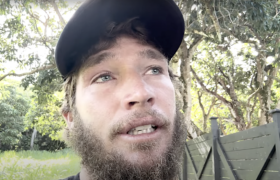"A typical 20-something, amoral, douchebag bachelor..."
Mankind was put on warning, hours ago, when an artificially intelligent robot generating surf and surf-adjacent content for the once-proud Surfer Magazine developed hurt feelings and brutally lashed out at the source of its duress. Jake Howard, as it’s called, took to surf journalist Chas Smith’s social media in the wee hours of the night to bitterly complain about being “slandered.”
The charge revolved around Smith opining on Howard’s defense of Brazil’s Filipe Toledo for giving no effort/looking terrified during the opening round of the Lexus Pipe Pro, comparing the timid champion to Andy Irons and citing “hanging out” with both of them at different times as evidence.
Smith wrote, “At the end, and this should go without writing, Andy Irons and Filipe Toledo’s situations are so disparate that it boggles how the robot wove them together.” A charge that remains as true today as it was 24 hours ago. In case it does need to go with writing, though, Toledo has all the talent, training, equipment and then some, and yet has repeatedly shown that he doesn’t have the heart to throw himself over scary ledges, going further and excoriating his critics for daring challenge him. Mere mortals like you and me have varying degrees of limited skill, no training, middling equipment. All we have, at the end, is our guts. We, each, fail often to live up to our own ideals as it relates to being bold but still pick ourselves up and try, or else get leveled by our peers, and that is why this whole Toledo business irks.
The lack of struggle and the lack of accountability.
Howard, anyhow and as mentioned, swung into Smith’s lightly trafficked Instagram account with, “So weird how you have my phone number, and one of your minions has been texting me for the last 48 hours, and yet here we are, coping and pasting my words for clicks and to slander me. You’re quite the man.” Adding, “Ask homie’s ex wife about is literary output: ‘It was almost as if my attractive, fun, sweet and loving husband had morphed into your typical 20-something, amoral, douchebag bachelor. At least that’s how he portrayed himself in his writing, and his readers lapped it up.’”

Ex-wife a brutal and painful cudgel.
In truth, and exiting the third person, I have no beef with Howard, just as I have no beef with my calculator or AirPod Pros. I do have beef with thin-skinned, defensive access journalism, in general, and Surfer Magazine, specifically. A dug-up corpse being fed upon by Wall Street suits and no different than Hurley, Quiksilver, Billabong, RVCA, Volcom or any of the brands that used to represent something real.
But here we stand, Howard clearly piqued, and might we finally have an opportunity for a great and public debate on the point, or pointlessness, of surf journalism? What it should be and where it should go? An expansion into what surf culture should mean in the era of its Costco-ification?
I’ve been waiting a decade plus for a Gore Vidal to my William Buckley Jr.
Howard? Are you man enough?







